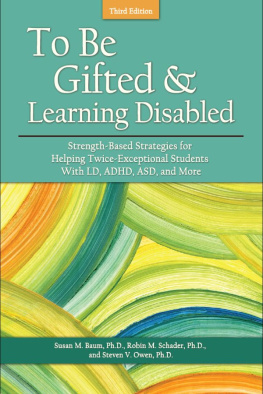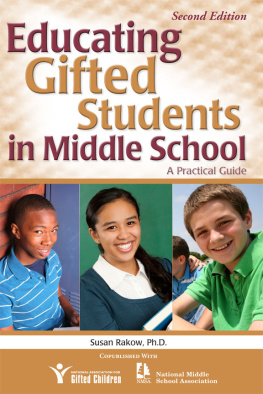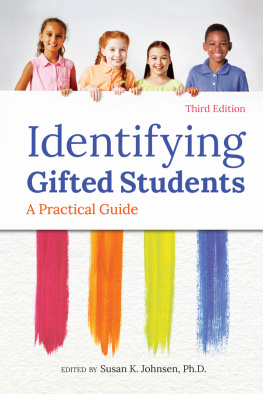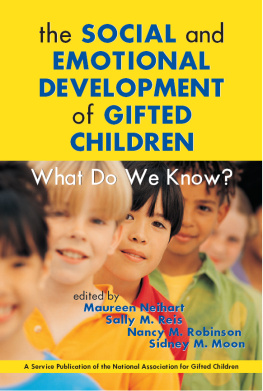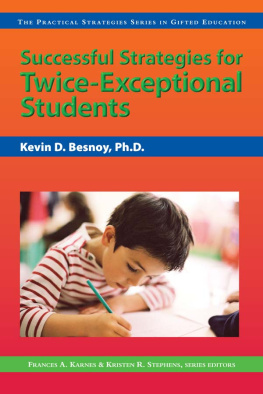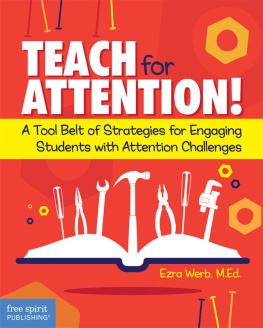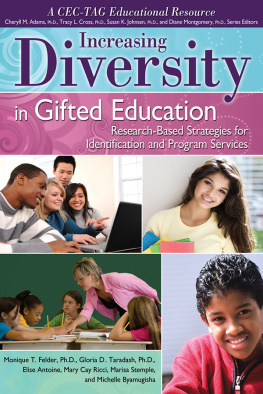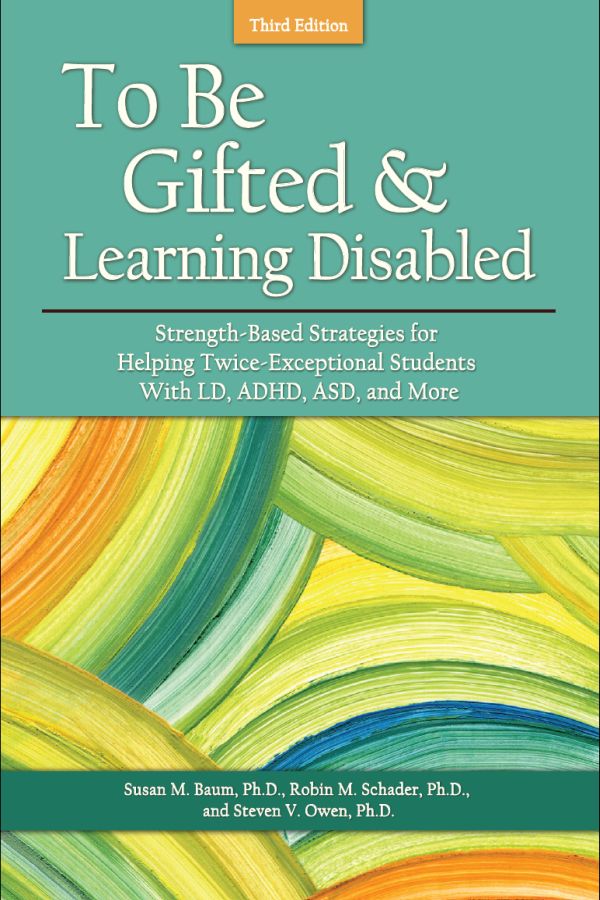


Library of Congress Cataloging-in-Publication Data
Names: Baum, Susan M., author. | Schader, Robin M., 1948- author. | Owen, Steven V., author.
Title: To be gifted and learning disabled : strength-based strategies for helping twice-exceptional students with LD, ADHD, ASD, and more / by Susan M. Baum, Ph.D., Robin M. Schader, Ph.D., and Steven V. Owen, Ph.D.
Other titles: To be gifted & learning disabled
Description: Third edition. | Waco, TX : Prufrock Press, Inc., [2017] |
Revised edition of: To be gifted & learning disabled. Mansfield Center,
Conn. : Creative learning Press, c2004. | Includes bibliographical references and index.
Identifiers: LCCN 2017019048 (print) | LCCN 2017021240 (ebook) | ISBN
9781618216458 (pdf) | ISBN 9781618216465 (epub) | ISBN 9781618216441 (pbk.)
Subjects: LCSH: Gifted children--Education. | Children with mental
disabilities--Education. | Attention-deficit-disordered
children--Education. | Learning disabled children--Education.
Classification: LCC LC3993 (ebook) | LCC LC3993 .B39 2017 (print) | DDC 371.95--dc23
LC record available at https://lccn.loc.gov/2017019048
Copyright 2017, Prufrock Press Inc.
Edited by Katy McDowall
Cover and layout design by Allegra Denbo
ISBN-13: 978-1-61821-646-5
No part of this book may be reproduced, translated, stored in a retrieval system, or transmitted, in any form or by any means, electronic, mechanical, photocopying, microfilming, recording, or otherwise, without written permission from the publisher.
At the time of this books publication, all facts and figures cited are the most current available. All telephone numbers, addresses, and websites URLs are accurate and active. All publications, organizations, websites, and other resources exist as described in the book, and all have been verified. The authors and Prufrock Press Inc. make no warranty or guarantee concerning the information and materials given out by organizations or content found at websites, and we are not responsible for any changes that occur after this books publication. If you find an error, please contact Prufrock Press Inc.

| Prufrock Press Inc.
P.O. Box 8813
Waco, TX 76714-8813
Phone: (800) 998-2208
Fax: (800) 240-0333
http://www.prufrock.com |
TABLE OF CONTENTS
Acknowledgements
This revision would not be possible without the wisdom, expertise, support, and comfort from those who have kept us focused on the idea that learning can be a joyful, rich process for twice-exceptional students. The privilege of being a part of the innovative and courageous Bridges community has deeply informed our practice and our vision. Thank you to the entire faculty, administration, specialists, parents, and students!
A special acknowledgement to our families, who have been our sounding boards and whose patience in reading, rereading, making suggestions, andmost of alllistening to us talk about our drafts, has been invaluable. And, many thanks to Edee Burke, who has been the inspired keeper of details.
Introduction
In an ideal world, school would be a wonderful place, full of exciting opportunities for learning and growtha place that nurtures talents, cultivates interests, and helps each student understand and manage his or her individual patterns of strengths and weaknesses. Unfortunately, in many classrooms, lessons are apt to be taught in the same ways for alland with student evaluations based on tests or other written products. Exciting curriculum is often reserved for that hypothetical time when students have mastered basic skills.
Within these classrooms are students who suffer in this type of learning environment because they cannot conform to what is expected, even though they have the capacity to contribute in exceptional ways in the classroom and, eventually, to society. When I wrote the first edition of this book in 1991 with Steve Owen, we titled the book To Be Gifted and Learning Disabled to specifically address students with learning disabilities whose intellectual and creative gifts were overlooked (termed GLD or GTLD), as well as gifted students whose learning disabilities were overshadowed by their advanced abilities (LDGT). By the time the second edition appeared in 2004, the field had expanded to include growing populations of students who, although intellectually capable, creative, and/or talented, are simultaneously burdened by a wide variety of learning differences that make traditional classroom approaches unsuccessful.
We now refer to these students as twice-exceptional (2e). In some areas they require learning opportunities that are beyond their grade level, and in other areas (cognitive, social, or emotional), they lack necessary age- or grade-level skills. When using the term 2e, we include high-ability students who may have any mix of specific learning disabilities, attention deficits, executive functioning issues, anxiety, autism spectrum disorders, and social and behavioral issues. Throughout the book, we use that broad term, only including a more detailed label if it offers additional information.
Notes on This Edition
My experience and research with Robin Schader during the past decade at Bridges Academy, a private school for 2e students (grades 412) near Los Angeles, CA, has been a major influence on this edition. In addition to working with a group of 170 students each year, plus staff and administration at the school, both Robin and I are also involved with the 2e Center founded at Bridges, which provides research, professional development, and outreach efforts for those living and working with 2e students.
How This Book Is Organized
To help twice-exceptional students, their parents, educators, and other professional school staff with whom these students interact, we present both theoretical perspectives and practical strategies for school and home. Using case studies and authentic examples of strategies that work, we hope to inspire you to help others understand these wonderful students and feel confident about advocating for them.
The book is divided into four parts. The purpose of is to introduce twice-exceptionalityboth as a field and as it pertains to individual students. After reviewing specific mixes of twice-exceptionalities, we offer a fresh lens to explain the complexities of dual diagnosis and why those complexities are best served through a strength-based, talent-focused approach.
is full of strategies for teachers, parents, and other professionals that will help them enhance students intellectual, physical, and emotional growth.
You will also find larger, detailed versions of many tables and figures on the books webpage at http://www.prufrock.com/Assets/ClientPages/tobegifted.aspx.
Susan M. Baum
Part I
The 2e Basics
CHAPTER 1
Twice-Exceptionality
Evolving Definitions and Perceptions
How can some students appear lazy and distracted in the classroom, applying little or no effort to school tasks, but then successfully pursue demanding and creative activities outside of school without missing a beat? Why, despite years of research findings, do educators, parents, relatives, and other professionals have such a hard time accepting the idea that children can have both high abilities and learning disabilities? These questions emphasize that many students face not only an obstacle course of internal and environmental challenges that threaten their academic achievement, but also a host of widely shared beliefs at home and at school that can obstruct their progress. Exploring the realities underlying these attitudes can help us understand this unique group of children, nearly all of whom have been unable to successfully learn in a traditional classroom setting.
Next page
